Browse the following selection in our
Egyptian Mythology page:
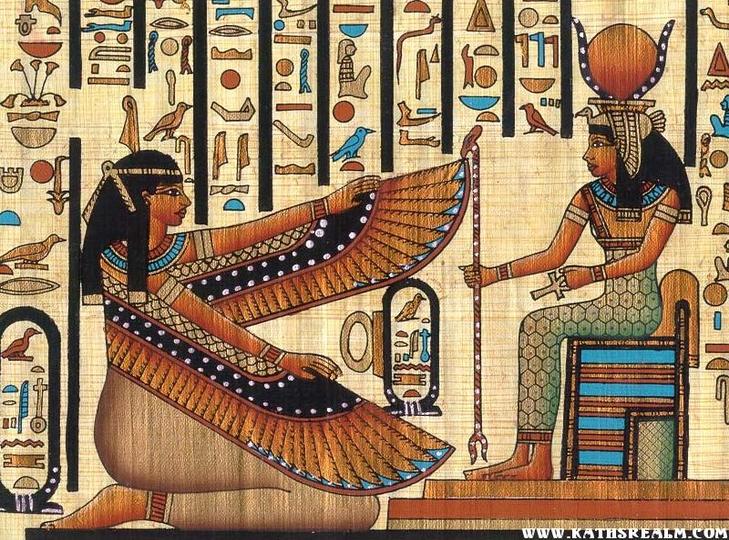 Egypt before the pharaohs.
Egypt before the pharaohs. 
The period we normally think of as "Ancient Egypt" is the time when Egypt was ruled by the pharaohs- after c. 3100 B.C. But who lived in Egypt before the pharaohs? In the early Stone Age people in Egypt lived on sites fairly high up on the land above the Nile from the Delta to Aswan. By about 5000 B.C, they had become farmers and began to grow wheat and barley, and to raise and domesticate cattle. They also built villages of mud huts in parts of the flood plain that seemed safe from the annual Nile flood. The farmers prospered and formed kingdoms. Recent
excavation shows that by 3,500 B.C, some of them were already living in cities and had made the first steps in inventing writing. They have left behind objects such as magnificently carved ivories, and slate palettes, as well as fine pots, often buried with their owners in brick lined graves.
Burials at this time, before mummification had evolved, involved arranging the corpse in a sleeping position with the elbows and knees drawn together. The body was placed in a pit with a selection of possessions, and sand was thrown on top of it. The sand absorbed all the water from the body, drying it out and preserving it, so that the person's spirit would recognize it and inhabit it.
On the banks of the Nile.
Desert covers more than 90% of Egypt. Called the Red Land, the desert is supported only small settlements in wadis and oases. The Egyptians lived on the banks of the river Nile or beside canals leading from it. This was Kemet or the Black Land, named after the
rich dark silt on which the farmers grew their crops. Without this fertility, there would have been no civilization in Egypt. Right up until modern times the pattern of life in Egypt for the majority of the population has depended on the exploitation of its fertile agricultural resources. Today the population explosion, growth of cities, and construction of large industrial plants is changing Egyptian lifestyles. The Nile flood began the year for the Egyptian farmer, when the river, increased by the rising waters of the Blue Nile and White Nile converging just north of Khartoum in the Sudan, brought deposits of silt into Egypt. When the Nile waters subsided the farmers got to work sowing barley and ember wheat. The result was usually a good summer harvest. The High Dam at Aswan, built in the 1960's, totally changed the regime of the river in Egypt.
Famous pharaohs.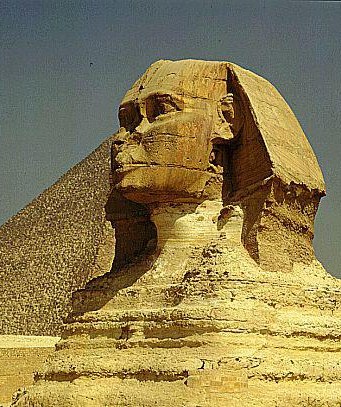
The king was not only the most powerful and important man in Egypt- he was thought to be a god. He was known as the pharaoh- a word which derives from a respectful way of referring to the king by describing him as the "great house", (per-ao), meaning the palace where he lived. The Queen of Egypt could also be seen as a goddess but was usually given the title of "Great Royal Wife"- only rarely did women rule Egypt in their own right. There was an effective system of training a prince to become a pharaoh, involving him becoming an expert sportsman and potential
war leader. Often the ruling pharaoh would adopt his heir as "co-regent" to enable a smooth take-over when he died. Princes sometimes had to wait a long time. One pharaoh holds the record for the longest reign we know of any monarch, Pepy II came to the throne when he was six years old. He was still king of Egypt 94 years later when he was 100. It is quite remarkable in Egypt's long history that we have only a few references to pharaohs being assassinated, usually as a result of a plot in the court to put a prince who was not the true heir on to the throne.
HatshepsutThis determined women ruled Egypt for about 20 years. She was supposed to be regent for her young stepson, but took over the reins of government. She wore the pharaoh's crown and royal ceremonial beard.
Akhenaten and Nefertiti.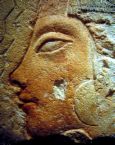
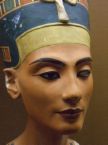
In Akhenaten's reign the traditional Egyptian gods were banished- only the sun god was worshiped. To break the links with other gods, Akhennaten founded a new capital city and closed the temples of other gods.
Queen Nefertiti helped her husband
set up the cult of the sun gods Aten and proberly ruled with him. After their death Tutankhamun and successors restored the old gods. The names of Akhenaten and Nefertiti became hated and were removed from inscriptions and their temples were torn down.
 Tutankhamun.
Tutankhamun.
This ruler came to the throne at only nine years old. He was obviously guided by his high officials, but seems to have been determined to bring back the old gods who had been banished by Akhenaten.
Ramesses The Great.In the 13th century B.C., Ramesses II reigned over Egypt for 67 years. He built more monuments and
set up more statues than anyother pharaoh.
Tuthmosis IV.This king was famous because he freed the great
sphinx at Giza from the desert sand that had blown around it.

He is protected by the cobra goddess
Wadjet on his forehead, only kings and queens were entitled to wear cobra goddess, who it was thought would deal out instant death by spitting flames at enemies.
Journey to the afterlife.Below the earth the ancient Egyptians imagined there existed an underworld which they called Duat. Some parts of it were full of perils like lakes of fire, poisonous snakes, and executioners. Spells were used to counteract these dangers. Many of them were written on coffins, together with a map of the underworlds. These developed into ornate scrolls of papyrus which we call Books of the Dead, since many were discovered on or near mummies. The book was a passport through all the perils lurking in Duat. If you could recite the correct spells, you could pass through unharmed. The ultimate danger was to fail the test
set for you in the Hall of the Two Truths, where your heart was weighed against your past deeds. The papyrus helped you as much as possible to pass the examination and reach a land that was just like Egypt itself.
Ram-Headed God.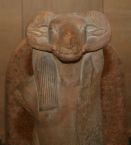
Sometimes statues of underworld gods were taken into the tombs in the Valley of the Kings. With their power to ward off evil, they were meant to protect the king as he traveled through the underworld. These gods had heads of creatures such as tortoises, hippos, or rams. They are quite different from other animal-headed deities, who flourished above ground.
Gods and Goddesses.The Egyptians worshiped hundreds of different Gods and Goddesses, and sometimes it is difficult to work out who was who. Many of the Gods are represented by animals; a baboon might stand for
Thoth, God of wisdom, at one temple, and a moon-God called Khonsu at another. Each of the 42 different administrative districts (or nomes) had its own God, and there were many others besides. Overall the sun-God was the dominant deity in Egyptian religion, although he could take different forms. At dawn he would be Khepri, the scarab beetle rolling the sun disc above the eastern horizon. In the evening the God was Atum, an old man. He could become Re-Harakhty, the great hawk soaring in the sky. He was seen as responsible for all creation- people, animals, the fertility of the soil, and the king's journey through the underworld. As
Amun-Re he was king of the Gods and protector of the pharaoh when he went on military campaigns. The pharaoh Akhenaten saw the sun-God as a disc with rays ending in human hands holding the sign of life to the royal family, and he banished all the other Gods. His son Tutankhamen restored them once more.
Amulets.The wedjet eye symbolizes both the vengeful eye of the sun god and the eye of the god
Horus, torn out by Seth in the struggle for the throne of Egypt, but magically restored. It was said to protect everything behind it. The scarab beetle symbolized the sun god Khepri. The real insect pushes a ball of dung around, and the Egyptians imagined that the sun was propelled in a similar way. The sacred ibis represents
Thoth, god of wisdom. The king of Egypt was the embodiment of the god
Horus and was therefore thought to be divine himself. The hawk-headed god was also a solar deity- the hawk high in the sky whose eyes were thought of as the sun and moon. The name
Horus in Egyptian meant "He who is far above".

 Bastet.
Bastet.The cat goddess
Bastet was the daughter of Re, the sun-god. She represented the power of the sun to ripen crops. Many bronze cat figures were dedicated in her now ruined temple in the northeast Delta.




 The period we normally think of as "Ancient Egypt" is the time when Egypt was ruled by the pharaohs- after c. 3100 B.C. But who lived in Egypt before the pharaohs? In the early Stone Age people in Egypt lived on sites fairly high up on the land above the Nile from the Delta to Aswan. By about 5000 B.C, they had become farmers and began to grow wheat and barley, and to raise and domesticate cattle. They also built villages of mud huts in parts of the flood plain that seemed safe from the annual Nile flood. The farmers prospered and formed kingdoms. Recent excavation shows that by 3,500 B.C, some of them were already living in cities and had made the first steps in inventing writing. They have left behind objects such as magnificently carved ivories, and slate palettes, as well as fine pots, often buried with their owners in brick lined graves.
The period we normally think of as "Ancient Egypt" is the time when Egypt was ruled by the pharaohs- after c. 3100 B.C. But who lived in Egypt before the pharaohs? In the early Stone Age people in Egypt lived on sites fairly high up on the land above the Nile from the Delta to Aswan. By about 5000 B.C, they had become farmers and began to grow wheat and barley, and to raise and domesticate cattle. They also built villages of mud huts in parts of the flood plain that seemed safe from the annual Nile flood. The farmers prospered and formed kingdoms. Recent excavation shows that by 3,500 B.C, some of them were already living in cities and had made the first steps in inventing writing. They have left behind objects such as magnificently carved ivories, and slate palettes, as well as fine pots, often buried with their owners in brick lined graves.





 He is protected by the cobra goddess Wadjet on his forehead, only kings and queens were entitled to wear cobra goddess, who it was thought would deal out instant death by spitting flames at enemies.
He is protected by the cobra goddess Wadjet on his forehead, only kings and queens were entitled to wear cobra goddess, who it was thought would deal out instant death by spitting flames at enemies.



 Edited by Egalitaria
Edited by Egalitaria